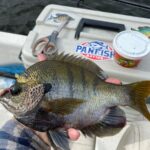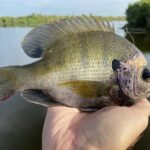If you have a fish tank or are interested in getting one, you may be wondering can you keep bluegill in a fish tank? Like wild bluegill, you’ve caught?
The answer is yes!
Bluegill make great pets and do very well in a freshwater fish tank given the appropriate setup.
Keeping wild-caught native fish is fun. It’s a great way to learn to observe the fish in your local lakes and streams.
For anglers, this is an excellent opportunity to learn from your fish’s behavior, and this can help you catch more fish on the water.
Let’s dive into this exciting topic!
This page contains affiliate links. As an Amazon Associate, I earn from qualifying purchases.
Table of Contents
Is it Legal to Keep a Bluegill as a Pet?
Yes, it is legal to keep bluegill in your home aquarium, but before keeping any fish from the wild, it’s important to check your local fishing regulations. Fishing regulations differ from state to state and apply differently to different locations, species, and fishing methods.
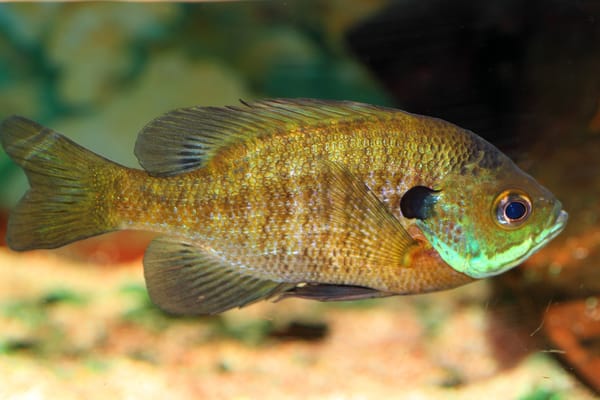
For example, in Florida, it is legal to keep bluegill, but they have some regulations. Bluegill are considered a gamefish, and cannot be kept using nets or traps; you must fairly catch them on rod and line.
In Florida, bluegill have no minimum size, but there is a bag limit.
Regulations can also change from lake to lake and river to river, so before keeping any fish make sure you’ve researched the regulations in your area.
What Size Tank do you Need for a Bluegill?
The size of the tank depends on the size and quantity of fish you want to keep. For just one bluegill, a 55-gallon tank would be ideal, but if you want to keep a few more, you’ll want a bigger tank.
Remember, bluegill can grow up to 10 inches long, so you need to plan for their max size.
Kitsa are available, such as this 55-gallon tank setup with everything you need to get started, or a smaller 20-gallon tank kit which is perfect for minnows and juvenile panfish.
Keep their size in mind when selecting the dimensions of your tank. You want to give your fish plenty of length to swim around freely.
What Filter Should you use for Bluegill?
There are many different types of filters. There are internal filters, external canister filters, hang-on back filters, sponge filters, and more! For bluegill, you can use any of these types of filters.
What’s more important, is the strength and size of the filter. Keeping a larger tank with more fish requires a stronger, larger filter to clean all that water and fish poop.
External filters are preferred for larger aquariums because of their efficiency and strength.
Do you Need an Aquarium Heater for your Bluegill?
Bluegill can naturally survive frigid temperatures and tropical temperatures. This makes them adaptable and easy to care for in an aquarium.
If your aquarium is indoors, heating is not required, but your fish may appreciate it. Bluegill are temperate fish, and they prefer temperatures between 65 and 80 ℉.
A simple digital thermometer is a must-have for any fish tank. Its the quickest and easiest way to monitor the water quality of your tank.
See My Amazon Picks: Best Panfish Lures & TackleWhat Should you Feed Bluegill in an Aquarium?
Bluegill are carnivores, so they will naturally prefer the live foods they hunt in the wild. You should feed your pet bluegill a variety of proteins. Feed your bluegill live or fresh food such as earthworms, mealworms crickets, minnows, crayfish, and shrimp.
Bluegill will also accept frozen foods. Keeping frozen foods such as frozen bloodworms, minnows, or shrimp will make it easier for you to feed your bluegill without having to restock on live food.
Also, feeding frozen foods can reduce the chance of your pet bluegill catching a disease from eating a sick live animal.
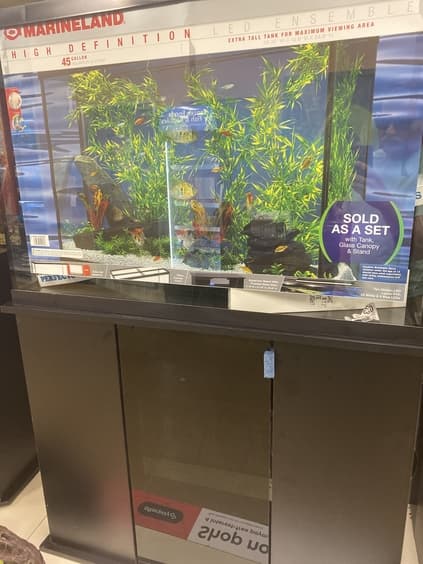
Keeping some pellet food around makes feeding your bluegill even more convenient than live or fresh. Fortunately, bluegill can easily be trained to accept dry pellet foods.
Some pellet foods, like Hikari Cichlid pellets, are created with a scientific formula that helps your fish grow faster and have color-enhancing effects. These pellets are highly nutritious and help your fish look its best.
Even if your fish is fully trained on frozen or pellet foods, it is a good idea to throw in some live food on occasion to keep their natural hunting instincts alive. It’s also fun to observe their hunting behavior in your aquarium.
Related: How Many Minnows Are In A Pound? Scoop? Gallon?
How Fast do Bluegills Grow?
The speed your bluegill grows will depend on what you feed it and the temperature of the water. If your bluegill is fed well, it can reach up to 9 inches within 1 to 3 years. Temperatures from 60-80 ℉ are optimal for faster growth. In the next few years, your bluegill may exceed 10 inches long.
How Long do Bluegills Live?
If you plan on keeping bluegill, be prepared for a fast-growing long-lasting pet.
In captivity, bluegill typically grow faster and live longer than they do in the wild. In a well-maintained aquarium, bluegill could live up to 11 years!
Can Bluegill Live with Other Fish?
Bluegill can live with other fish in your aquarium, but you must be selective with tank mates! Bluegill are carnivores, so you should not put your bluegill with other fish which are much smaller than them as they may try to eat them!
Bluegill are curious, opportunistic feeders, and they will likely try to eat any animals that can fit in their mouths.
Bluegill can also be territorial and may fight with similar-sized fish. Having a large enough tank will help alleviate territorial feuds, but sometimes one individual may be more territorial than others.
If you plan on keeping other fish with your bluegill, it’s a good idea to have a backup tank in case they don’t get along.
Are Bluegill Good Tankmates for a Goldfish?
As long as they are similarly sized, bluegill and goldfish can live together in your aquarium. Make sure your tank has plenty of space for both fish so that they aren’t cramped in uncomfortable conditions.
Can I Put Live Plants with my Bluegill?
Live aquarium plants are a great addition to any aquarium. They look great and help oxygenate your water and help decrease excess nutrients. You can keep live plants with your bluegill, but your bluegill may damage or destroy them.
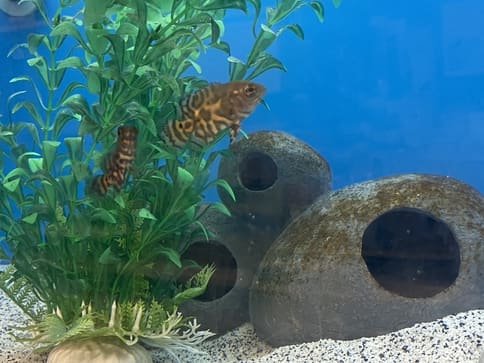
Bluegill like to dig around and make beds in spectrastone gravel during the springtime. Even if your bluegill isn’t with a partner, they may still follow their instincts and try to bed. If this happens, your live plants may be uprooted.
For a bluegill tank, start with hardier fast-growing plants like java fern, amazon sword, Indian waterweed, and elodea.
Some aquatic mosses will grow well too, like java moss. Marimo moss balls are especially hardy and will compliment a bluegill planted tank.
Will Bluegill Breed in an Aquarium?
If you have a male and female together, and the conditions are right, your bluegill will likely try to spawn.
If you don’t use a heater your bluegill may try to spawn in the spring or summer.
Related: Bluegill Spawn- Temperature, Habitat, Biology and More.
The first sign of spawning will be increased aggression towards other fish in the tank. They will fight with tank mates to claim territory. If they start making a bed, they could lay eggs within a few weeks.
Conclusion
Keeping pet bluegill in your fish tank or aquarium at home is a great way to observe these unique panfish. You can really learn a lot about a species!
Growing up, my father had a freshwater fish tank and I loved watching the bluegill, warmouth, shellcracker, and even crawfish frolic and swim around.
I learned quickly what foods they preferred, where they like to hang out, and even the changing colors as they age.
If you are curious about freshwater fish tanks, I encourage you to give them a try. Good luck!
You May Also Like: The Complete Guide To Raising Minnows For Bait
If you haven’t guessed yet, I love fishing and everything about it!
To learn more about why I started Panfish Nation, visit the About page and follow along on Social Media:


Download a copy of my FREE Lure Color Selection Chart & Knot Guide!
Stay up to date with fishing reports, tackle reviews, industry news, and much more! We respect your privacy, unsubscribe at any time.
Related Posts
- Crazy Facts About the World Record Crappie
- What Size Hooks for Smallmouth Bass? Quick Guide
- Large and in Charge-Mouth: 10 of the Best Bass Lures of All Time (And Where to Buy Them)
- Emperor of the Sun(fish): What You Need to Know About the World Record Bluegill
- Coppernose Bluegills: How They’re Different from Common Bluegill
- Bluegill vs Brim: Differences & Terminology, Explained!





